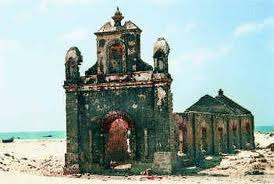Historic map of Dhanuskodi before 1964
Dhanushkodi (Tamil for the end of the arc) called today a place on the island in the Indian state of Tamil Nadu Pamban, about 4 km before the end of the sandy spit of land that runs from the island east to Adams Bridge.
Current location
Dhanushkodi (Tamil for the end of the arc) called today a place on the island in the Indian state of Tamil Nadu Pamban, about 4 km before the end of the sandy spit of land that runs from the island east to Adams Bridge.
Current location
There are a few thatched fishermen's cottages, modest places of worship, a snack bar and various remains of walls, etc. a station, a church, a water tank and a post office. From the center of the island, a paved road to a post of the Indian Navy for about 4 1 / 2 miles from Dhanushkodi, and from then there is only a sand road.Religious significance
The place has spiritual significance for Hindus. Its name is derived from the bow of the god Rama, who was designated by its end of the place from which should be built from Ramasbrücke (Adam Bridge) to Sri Lanka. A pilgrimage to Rameswaram to connect with a swim in the sea near Dhanushkodi, the confluence of the waters of the Gulf of Bengal and Indian Ocean .
Place until 1964
By 1964, Dhanushkodi was next to the famous for its temple is the most important place of Rameswaram island. Dhanushkodi had all the necessary for a pilgrimage and tourist facilities. The Indo-Ceylon Express of the Southern Railway, then called Boat Mail, regularly drove the 675 km route from Madras Egmore Station (now Chennai) to Dhanushkodi pier. They drove for example in 1950 from Madras at 20:00 in clock, came the next day in Mandapam, the last place on the mainland, at 13:02 on where time was for a medical examination of passengers traveling abroad. After the ride opened in 1914 on the Pamban Bridge, the train stopped at 14:12 Pamban in town where you could switch to Rameswaram, and finally arrived at 15:05 am Dhanushkodi pier. There was up from the ferry shortly after 16:00, the need for the trip to Talaimannar in Ceylon (now Sri Lanka) about 3 1 / 2 hours. On Sunday evening the ship but not wrong. From Talaimannar could be with the Northern Line proceed to Colombo. On the return journey the train was at the pier from Dhanuskodi at 12:05 and arrived the next morning at 7:25 in Madras.
Cyclone 1964
On the night of 22 to 23 December 1964 was Dhanushkodi (as well as the whole island) hit by a cyclone with extreme winds and several feet high waves. The peninsula was flooded, a straight drive into the Zug train station destroyed and the city and the railroad literally washed into the sea. The number of victims, including about 115 people on the train was on more than 1,800 estimated.

The place has not been rebuilt. The ferry, which was also interrupted by the destroyed piers at both ends of the route was later replaced by a ferry service between Rameswaram and Talaimannar, but it was also adjusted 1984/85. The railway line in Sri Lanka was abandoned by Madawachchiya after Talaimannar
On the night of 22 to 23 December 1964 was Dhanushkodi (as well as the whole island) hit by a cyclone with extreme winds and several feet high waves. The peninsula was flooded, a straight drive into the Zug train station destroyed and the city and the railroad literally washed into the sea. The number of victims, including about 115 people on the train was on more than 1,800 estimated.

The place has not been rebuilt. The ferry, which was also interrupted by the destroyed piers at both ends of the route was later replaced by a ferry service between Rameswaram and Talaimannar, but it was also adjusted 1984/85. The railway line in Sri Lanka was abandoned by Madawachchiya after Talaimannar























